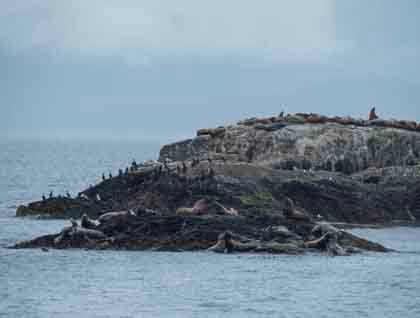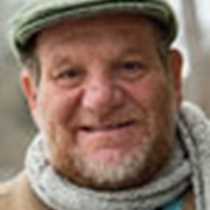It was lightly raining when we stopped at Bartlett Cove to pick up our National Park Ranger, Amy, and our Tlinget Native Cultural Interpreter, Leonty. This gave all of us pause because today’s exploration is in Glacier Bay National Park, and besides being full of wildlife opportunities, it is one of the most scenic places in North America. Leonty would tell us that the native people view the entire park as a living entity. Fortunately for us, the spirits of Glacier bay smiled upon us and as we sailed into the main body of the park the weather became better and better.
It was not long after breakfast when we made our first wildlife stop, South Marble Island. South Marble Island is host to an incredible selection of wildlife. We saw a large colony of Steller sea lions; cliffs filled with nesting puffins, kittiwakes, murres, and cormorants who all call the island their home. As we watched the sea lions hauled out on the rocky shores, myriads of seabirds circled the ship. We all got our first look at puffins and as one or more flew by us, cameras and binoculars were trained on the colorful birds capturing images in our cameras and in our minds.
As we continued into the bay we stopped at Gloomy Knob and spotted our first brown bear of the expedition. In the native tongue of the Tlinget, the name of this place literally translates into “land of many goats,” and the place lives up to its name. We see one, and then another, and then more. It is nice when names are so accurate. As we sail, there is a steady parade of eagles, sea otters, and many species of seabirds. During the quiet times, in between wildlife sightings, we hear stories about Tlinget native traditions from Leonty, and more about the history of Glacier Bay from our Park Ranger Amy.
Next was another highlight of our adventure, Marjorie Glacier. As we neared the face of the mighty ice, a brown bear was spotted on the hillside. He was grazing on the vegetation and we watched and enjoyed the experience of viewing the bear, quietly and without human interference. Another of the bruins was spotted in another area of the hills before we turned the vessel towards the glacier, a mile wide wall of ice, towering above fiord.
There is never any way to know when glaciers will calf, sending ice crashing into the sea. It is not noise, or weather, or anything we can do to help it along. In order to see a glacier calf you need only one thing, patience. Glaciers are used to taking their time. It has been hundreds of years since the snow falling from the sky began its journey of metamorphosing into the ice that we see today. It did not matter that the glacier took its own time for us to see it calf, watching the ice, listening to the voice of the ice, moans and cracks, is enough to satisfy us. Then, without warning, the ice lets go and then a huge chunk of the face of the glacier falls from the glacier.
We head back to Bartlett Cove to return our Native Guide and Park Ranger. Once there, we take the opportunity to hike along some of the trails near the park headquarters. We wander the woods with a new understanding of how the glaciers have shaped the land beneath our feet, and look forward to what our expedition holds for us tomorrow.







